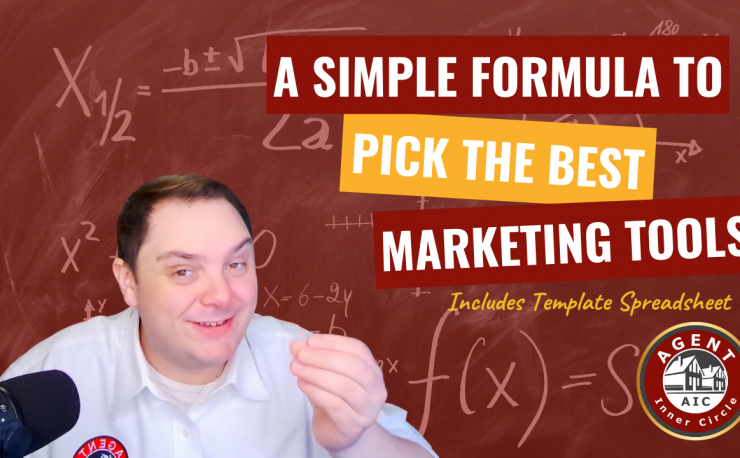What if I told you $100 means nothing? How about $100,000 or even $1,000,000?
All these Year End, Black Friday, Cyber Monday and other deals have me thinking about the common misconception of the relationship between money – and value.
Let me give you an example to illustrate what I mean using the statement: “I spent $100 on marketing.” So, is that a lot?
If we’re talking about a 6-year old’s lemonade stand, $100 in marketing is frankly astronomical. However, if we’re referring to Amazon’s marketing budget, $100 is inconsequential.
Without context, “$100” has no relative value, and this is where humans start to get in trouble. Our brains prefer to give absolute values to things instead of relative values.
I see this play out in the Real Estate industry all the time with statements like, “They can use print marketing because they’re a multi-million dollar company”, or “I’d buy this marketing tool if it was $100 cheaper.”
As Einstein famously said, everything is relative, and that’s actually the key to setting some simple ground rules that we can follow to make smarter investments.
Consumer Goods vs. Investments
First, we need to learn to assess consumer goods differently from the investments we make in our businesses.
For many of us, a $1,000 purchase in our everyday lives is a sizable amount of money, and at the very least makes us pause and really think about it. However, in business, this is where relativity starts having an impact.
Various sources (Gartner, Salesforce and others) estimate that as a small business, you should be spending between 7% to 15% of your gross revenue on marketing. So, if you’re looking to make $100,000 this year, you need to spend between $7,000 and $15,000 on your marketing. To drill down even further, that’s between $583 – $1,250 per month.
So that $1,000 purchase that may give us significant pause in our everyday lives, is also the amount we need to be spending each month in order to hit our revenue goals.
Let me ask – are you spending $1,000 per month on your marketing? (Note: this does not include the general operating expenses for your business – this is just for marketing!)
Thinking In Returns
Let’s take this a little further, because maybe you want to make $200,000 – or $500,000 – this year, and you’re trying to figure out what tools and strategies you can invest in to get you there.
In this case, what we’re looking for is your Relative Return on Investment (aka how many dollars you get back for each $1 you invest), and simply comparing the cost of each tool (or even the advertised ROI) won’t quite do it. We still need to add one more critical factor, which is your confidence level in the tool or strategy. It doesn’t matter what the tool costs – how much you save – or what the potential return is, if you don’t believe in it.
This confidence rating can be based on a lot of different factors from your research, like demos, and testimonials or recommendations from other agents who have had success with that tool. Plus, you’ll want to make sure to take into account whether the strategy matches your style, because that’s often a huge component for success.
The Winning Formula
By putting all of the pieces together, we have a simple formula for finding the relative return of the tools we’re trying to compare:
(Return Goal x Confidence) / Investment = Relative Return
Now all you have to do is compare the Relative Return with each potential investment and voila – you know which one is a better purchase.
Let’s look at a couple of examples of this so we can see how it all plays out. We’ll start with the goal of making $100,000 this year.
| Tool #1 | Tool #2 |
| In ideal circumstances Tool #1 can generate half your income ($50,000) and you give it a confidence rating of 90%. The total cost of investing in the tool is $4,000. ($50,000 * 0.90) / $4,000 = $11.25 | In ideal circumstances Tool #2 can generate one quarter of your income ($25,000) and you give it a confidence rating of 60%. The total cost of investing in the tool is $1,500. ($25,000 * 0.60) / $1,500 = $10.00 |
| Relative Return: $11.25 | Relative Return: $10.00 |
^^^^ This is the TRUE value per $1 you invest ^^^^
Using this method, we can quickly see how at face value, Tool #2 might look like a better investment, but may not be the better option for your business.
Real World Case Study
So far, we’ve only used theoretical examples but let’s use one of our community’s favorite tools, Service For Life!, as a real-world example to see how this plays out. We’ll use the lower end of any ranges in our formula to show the ‘worst case scenario’ mathematically.
Agents consistently share that they make 70% to 100% of their 6-figure income from the Service For Life! tool (which is about $70,000/year on the low end). The total cost of investing in the tool is dependent on a few factors, but if you were to send a printed version of the newsletter to 150 people each month, you would spend about $3,899 over the year ($899 for Service For Life! + $3,000 for printing and mailing.)
So now, it really just comes down to how confident you are that it will work?
Let’s say you’re only 70% confident that the Service For Life! system will work, your Relative Return on Investment would be $12.57!! ($70,000 x 0.70)/$3,899 = $12.57
That’s $12.57 for each $1 you invest – and that is a real-world “worst case” scenario based on the agents who actually use this tool!
Time to Compare
I urge you to do this analysis and thoroughly compare the tools you’re already using – or thinking of incorporating – in your business.
To make this easy, I’ve created a spreadsheet template that you can download and easily fill in. Just sort it by the ROI column and you’ll see your most valuable investments laid out right before your eyes.








Leave a Reply